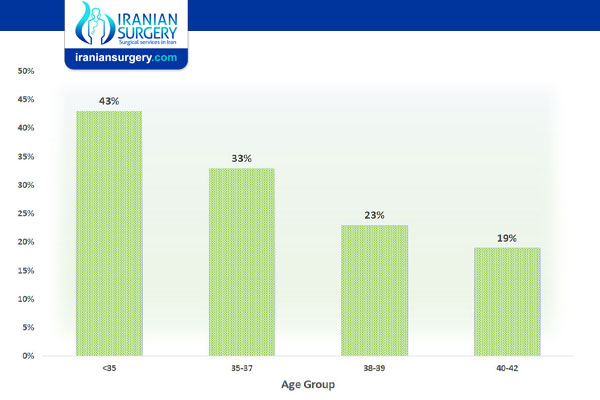IVF Success Rates 25 Years Old
IVF Success Rates 25 Years Old
There are so many factors that affect pregnancy rates, but few are as important to consider as the age of the mother. Age can impact your ability to become pregnant naturally as well as your success during an in vitro fertilization (IVF) cycle.
Fertility Rates by Age
According to a feature by the publication Parents, these are the average pregnancy rates for women in different age groups:
. Women Age 20 to 24 - 96 percent chance of conceiving in a given month
. Women Age 25 to 34 - 86 percent chance of conceiving within a year of trying
. Women Age 35 to 39 - 78 percent chance of conceiving within a year of trying
. Women Age 40 to 44 - 10-12 percent chance of conceiving
. Women Age 45 and Older - 3-4 percent chance of conceiving
Risk of Pregnancy Loss by Age
The Mayo Clinic estimates that 10 to 20 percent of pregnancies end as a result of a miscarriage before the 20th week. As women get older, the chances of pregnancy loss get higher. At age 35, the risk of pregnancy loss is around 20 percent; at 40, the risk is 40 percent; and 45 and older, the risk is as high as 80 percent.
Why Age Matters in IVF
When performing IVF, quality eggs are essential for treatment success. As women get older, the quality of their eggs tends to be lower. This is one of the major factors that affects both fertility rates and the rates of pregnancy loss as women get older.
A young woman is more likely to be at the peak of her reproductive health, which makes pregnancy much more likely, whether through natural conception or professional fertility treatment. This is why a consultation at Iranian Surgery is essential, allowing us to go over all of the risks, benefits, and realities of IVF treatment.
Success Rates of IVF by Age
According to the American Pregnancy Association, these are the overall success rates for IVF treatment by age group:
. Women Younger Than 35 - 41-43 percent
. Women 35 to 37 - 33-36 percent
. Women 38 to 40 - 23-27 percent
. Women Older Than 40 - 13-18 percent
Can I Undergo IVF If Age Is a Fertility Issue?
You can try, though if there is a significant risk of pregnancy loss or a birth defect, we may advise you to reconsider IVF. Your health and the health of your child are of paramount importance to us.
Developing a Fertility Treatment Plan for You
If you are older and a pregnancy could be risky, there are many options to consider that can still allow you to have children. We may recommend working with an egg donor, who can provide high-quality eggs for an IVF cycle. Similarly, we may recommend working with a gestational carrier, who can carry a child to term for you without risking pregnancy loss.
About Iranian Surgery
Iranian surgery is an online medical tourism platform where you can find the best doctors and fertility specialists in Iran. The price of IVF in Iran can vary according to each individual’s case and will be determined by an in-person assessment with the doctor.
For more information about the cost of IVF in Iran and to schedule an appointment in advance, you can contact Iranian Surgery consultants via WhatsApp number 0098 901 929 0946. This service is completely free.
Source:
https://www.losangelesreproductivecenter.com/blog/2019/09/28/how-age-affects-ivf-results-201463


